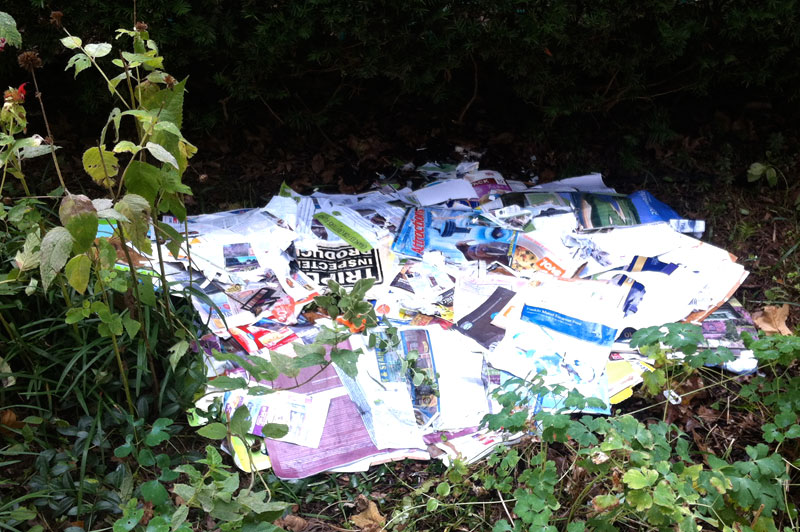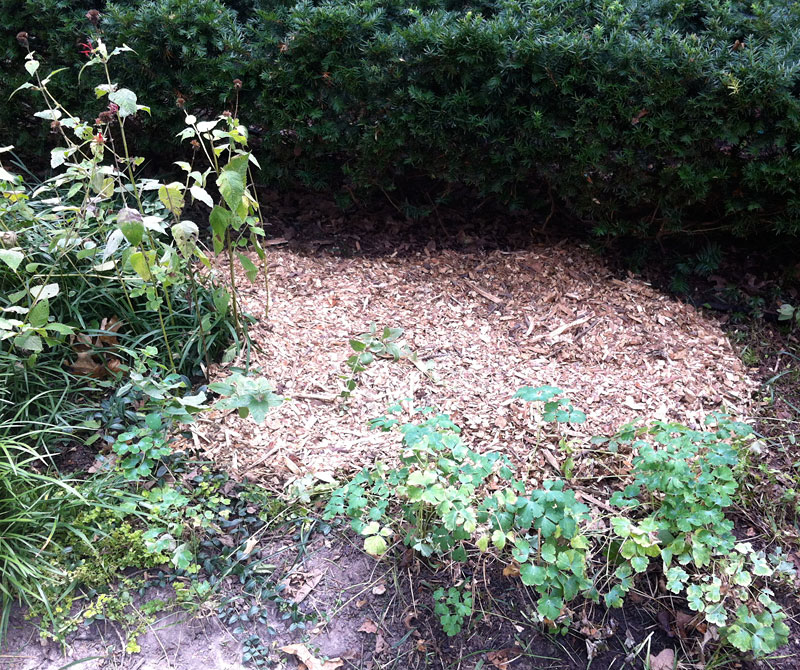Fall Garden Cleanup
In my previous article “Make a Garden Sign Out of a Recycled Produce Crate” I explained that I wanted signs to let the groundskeepers at my condo complex know that I did not want them to remove the fall leaves from my garden, especially with leaf blowers, or trim or spray the plants. The condo management has agreed to let me manage fall garden cleanup myself this year as an experiment and has let the landscaping company know to leave my garden alone. Here are the reasons why I think this will improve my garden:
- When the leafblowers remove the leaves, they also knock over my plants, blow away plant tags, blow away fertilizer, blow my mulch into the lawn and blow seeds out into the lawn which makes the lawn weedy and my plants less likely to reseed themselves.
- Trimming the plants in the fall destroys hibernating beneficial insects and removes winter food and cover for birds from the garden.
- The resulting bare soil is more likely to erode and I lose plants over the winter due to the soil drying out and freezing more deeply than it would with a natural cover.
- I have to water more often to compensate for the lost moisture and that costs the condo complex money.
- My gardening space is all part shade and shade plants are adapted to living under tree litter for the most part rather than bare soil so it’s difficult to get things to grow.
- The groundskeepers don’t necessarily know which plants I want and which ones I don’t and they often spray the wrong ones with herbicide. I can’t label them because the leaf blowers blow the markers away. Even if they always sprayed the right ones, I don’t want poison around my home. I’d rather pull the weeds and compost them or smother them with lasagna gardening.
So how do I propose to handle garden cleanup this fall?
One of the first gardening books I bought after moving into my condo was “Making the Most of Shade” by Larry Hodgson since I was new to shade gardening at the time. I haven’t reviewed it for awhile so I got it out to see if it had anything helpful about managing leaves.
Here is some of what Hodgson has to say about removing leaves and dead plant material in the fall:
“It doesn’t help the plants in any way, and it removes the organic matter that would have decomposed on the spot to feed the plants… …I find the less I disturb plants, the better they grow.”
The kind of fall cleanup I’d like to do is none at all. Will that work? I know the groundskeepers will need to remove leaves from the lawn, because the lawn will die if they are not removed or chopped up on the spot. My garden will be a nuisance if leaves blow off of it onto the lawn and I don’t want to cause problems. I plan to toss some wood chip mulch over the leaves periodically to keep the leaves in place. If the resulting leaf/mulch piles threaten to exceed 8 inches in depth (if you go over that you may harm tree roots) then I plan to remove some of the leaves and either chop them and return them to the garden or use them in one of the other two gardens I help manage. My perennial plants if left alone should do some of the work of holding leaves in place also.
The trees around my condo are almost all oaks and I’ve read that oak leaves may form a mat which keeps water from getting through to the ground and they are also slow to break down. Nitrogen helps dead leaves break down faster, so whenever I apply wood chip mulch I will also add some high-nitrogen organic fertilizer.
I’m also going to experiment with growing oats as a cover crop over the leaves in spots. I’m already having some success with growing oats in leaf mounds with no soil added in a client’s garden. If I have the same results in my garden the oats should be helpful. I hope that the oats will perform four tasks for me:
- Help hold leaves in place.
- Pierce leaves with their roots so that water can get through.
- Feed small birds with their seed heads.
- Decompose after they die and eventually feed my other plants.
The oats die off in winter so they should not become weedy. Schnarr’s can special order some oats for you so you can try this in your own garden if you’re interested in cover crops.
Stay tuned for a report on the results of my experiments!


